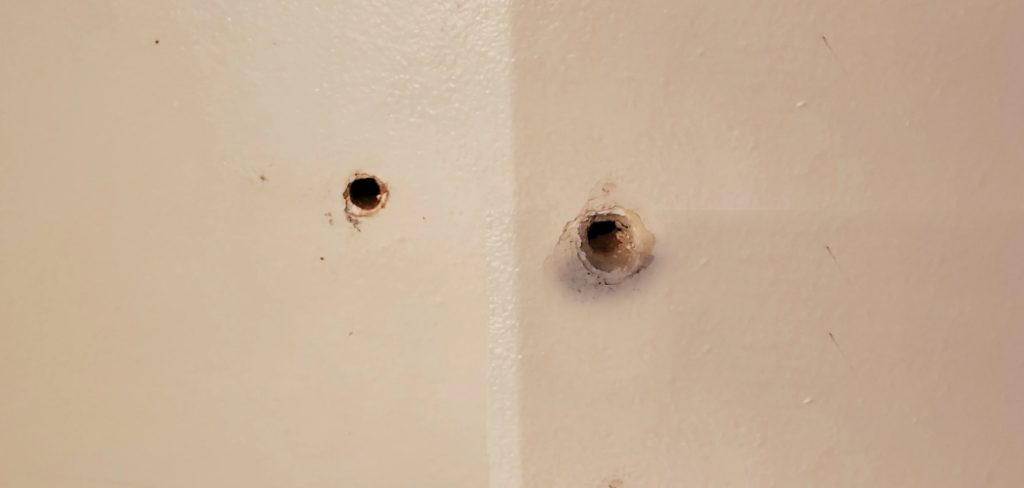Hey there! Are you tired of looking at those unsightly screw holes in your concrete wall? Do they make you feel like your home is a construction site instead of a cozy living space? Don’t worry, my friend, I’ve got you covered.

Today, I’m going to talk about how to fill screw holes in a concrete wall and give your home a clean, polished look. It’s a simple DIY project that anyone can do with the right tools and materials. So, grab your tools, and let’s dive right in!
Step-by-step Guide To Fill Screw Holes In Concrete Wall
To effectively fill screw holes in a concrete wall, you’ll need the suitable materials and a systematic approach. Here’s a step-by-step guide:
Materials needed:
- Concrete patching compound (also known as hydraulic cement)
- Alternative: Use Portland cement mix, DAP cement patch (Not for the bigger holes)
- Water
- Mixing container
- Putty knife or trowel
- Small brush (optional)
- Vacuum cleaner
Step 1 – Preparation
Before you begin the repair process, thoroughly clean the area surrounding the screw holes. Use a vacuum cleaner to remove any other loose debris or dust from the concrete surface. This step is crucial for achieving a solid bond with the patching compound.
Step 2 – Mix the Patching Compound
Follow the instructions on the patching compound’s packaging to prepare it with the appropriate amount of water. Be sure to adhere to the manufacturer’s guidelines, as the water-to-compound ratio may differ between products. The resulting mixture should resemble a thin paste in consistency.
Step 3 – Apply the Patching Compound
Use a putty knife or trowel to evenly apply the mixed patching compound over the screw holes, ensuring complete coverage. Press the compound firmly into the hole’s edges to establish a secure bond.
Step 4 – Smooth the Surface
With the putty knife or trowel, smoothen the patched area’s surface. Feather it out towards the surrounding concrete to seamlessly blend it in. Make sure to eliminate any air pockets or bubbles that may have formed during the application process.
Step 5 – Allow It to Set
Let the patching compound set the recommended time according to the manufacturer’s instructions. It may vary depending on the product; however, it’s usually around an hour or more.
Step 6 – Sand the Surface
After the patching compound has been fully set, use a sanding block or sandpaper to create a flat finish, removing any excess material. This will leave you with a smooth and well-repaired concrete surface.
Don’t Do
Don’t Make the Hole Bigger
While it may seem counterintuitive, making the hole more significant in size than it needs to be can weaken the surrounding concrete, leading to further damage and instability in the future. Only make the hole as big as necessary to accommodate the repair material.
Using Caulk
Caulk is not an appropriate choice for repairing holes in cement or concrete blocks because it does not adhere effectively to these surfaces and possesses different properties than concrete and cement.
FAQ’s
Can I Paint Over the Filled Hole?
Absolutely, yes; once the concrete patch has dried, gently sand it to smooth the surface, wipe away any dust, and then paint it with a matching color to blend with the wall.
How Long Does It Take for the Filler to Dry?
The drying time for filler can vary depending on the specific product you’re using, the depth of the hole or crack being filled, and environmental conditions like temperature and humidity. Generally, most concrete patching compounds take up to 4 hours to dry to the touch.
Can I Reuse the Same Holes for Screws After Filling Them, or Do I Need to Drill New Ones?
In most cases, it’s not advisable to reuse the same holes for screws after filling them with patching compound, mainly if the holes were drilled initially for a significant load-bearing purpose.
Can I Use Regular Spackle or Filler for Concrete Screw Holes?
Regular spackle or filler, typically used for drywall repairs, is not suitable for filling screw holes in concrete. Concrete has different properties and requirements compared to drywall, so it’s essential to use an appropriate material for this purpose.
Conclusion
When it comes to repairing screw holes in concrete, using suitable materials and techniques is crucial for a successful and durable fix. Remember to clean the area, apply a concrete patching compound, and follow the recommended drying and painting steps for a seamless repair.
Share this valuable information with your friends and anyone who might find it useful. Please share your thoughts and experiences with concrete repairs in the comments below.
You may read also – How to Fill a Screw Hole in the Wood for Reuse
